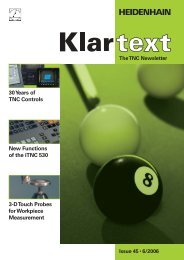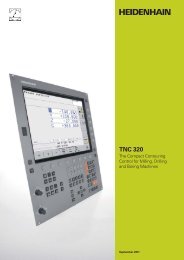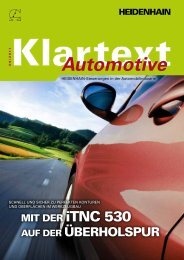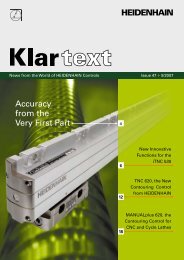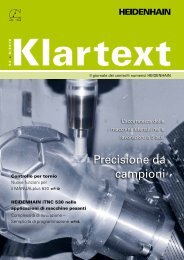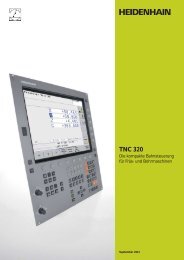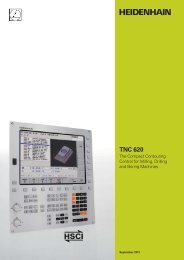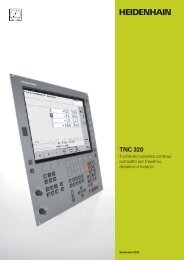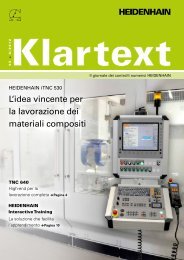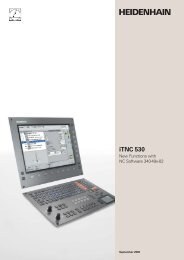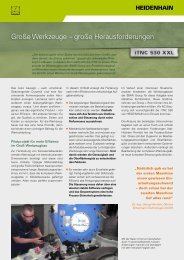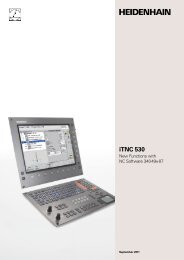iTNC 530 - TNC 640 - DR. JOHANNES HEIDENHAIN GmbH
iTNC 530 - TNC 640 - DR. JOHANNES HEIDENHAIN GmbH
iTNC 530 - TNC 640 - DR. JOHANNES HEIDENHAIN GmbH
You also want an ePaper? Increase the reach of your titles
YUMPU automatically turns print PDFs into web optimized ePapers that Google loves.
Open for Communication<br />
– Program Offl ine and Enjoy the Advantages of the <strong>i<strong>TNC</strong></strong><br />
Frequently, 5-axis programs are written on<br />
offl ine CAM systems and then transferred<br />
to the control over a data line. Here, too,<br />
<strong>i<strong>TNC</strong></strong> <strong>530</strong> performance comes to the fore.<br />
The fast data transfer over the Ethernet<br />
interface functions safely and reliably, even<br />
with large 3-D programs. You can make full<br />
use of the <strong>i<strong>TNC</strong></strong> <strong>530</strong>’s ease of use—even<br />
for offl ine programming.<br />
The <strong>i<strong>TNC</strong></strong> <strong>530</strong> works very well together<br />
with all CAM systems. <strong>HEIDENHAIN</strong><br />
intensively supports the manufacturers of<br />
postprocessors for the best possible use of<br />
the <strong>i<strong>TNC</strong></strong> <strong>530</strong>’s powerful features.<br />
38<br />
Programs created offl ine<br />
NC programs for fi ve-axis operations are<br />
normally written on CAM systems. The<br />
workpiece geometry is described in the<br />
CAD system, while the required technology<br />
data is added in the CAM system. The<br />
technology data specify the methods (such<br />
as milling, drilling, or boring), the strategy<br />
(area pocket clearance, plunge milling, etc.),<br />
and the parameters (spindle speed, feed<br />
rate, etc.) for machining the workpiece. A<br />
postprocessor uses the geometry and<br />
technology data to create an executable<br />
program, which is then usually transferred<br />
over the company network to the<br />
<strong>i<strong>TNC</strong></strong> <strong>530</strong>.<br />
In principle, postprocessors generate two<br />
types of NC programs, both of which can<br />
be run by the <strong>i<strong>TNC</strong></strong> <strong>530</strong>:<br />
Machine-specifi c NC programs take the<br />
respective machine confi guration into<br />
account and include all coordinates of<br />
the NC axes on that machine.<br />
Machine-neutral NC programs defi ne the<br />
contour and use vectors to defi ne the<br />
respective tool position on the contour.<br />
The <strong>i<strong>TNC</strong></strong> <strong>530</strong> then uses the information<br />
to calculate the axis positions of the<br />
actual machine axes. The key benefi t<br />
here is that you can run such NC<br />
programs on various machines with<br />
differing axis confi gurations.<br />
The postprocessor is the link between<br />
the CAM system and the CNC control.<br />
Standard features on all prevalent CAM<br />
systems include post-processors for DIN/<br />
ISO format as well as for the proven and<br />
user-friendly <strong>HEIDENHAIN</strong> conversational<br />
format. This enables you to use special<br />
<strong>TNC</strong> functions that are available only in<br />
conversational format. Examples are:<br />
Tool Center Point Management (TCPM)<br />
Structuring function<br />
Special Q-parameter functions<br />
Program optimization is also easy. As<br />
usual, the conversational programming is<br />
graphically supported. And of course you<br />
can use all proven setup functions of the<br />
<strong>i<strong>TNC</strong></strong> <strong>530</strong> to quickly and economically<br />
locate the workpiece.<br />
CAM systems don’t always generate<br />
programs optimized for the machining<br />
process. Therefore, the <strong>i<strong>TNC</strong></strong> <strong>530</strong> offers a<br />
point fi lter for smoothing externally created<br />
NC programs. The fi lter function creates a<br />
copy of the original program, and then adds<br />
any points required by the parameters that<br />
you set. This smoothes the contour to<br />
allow the program to run more quickly and<br />
with less jerk.



